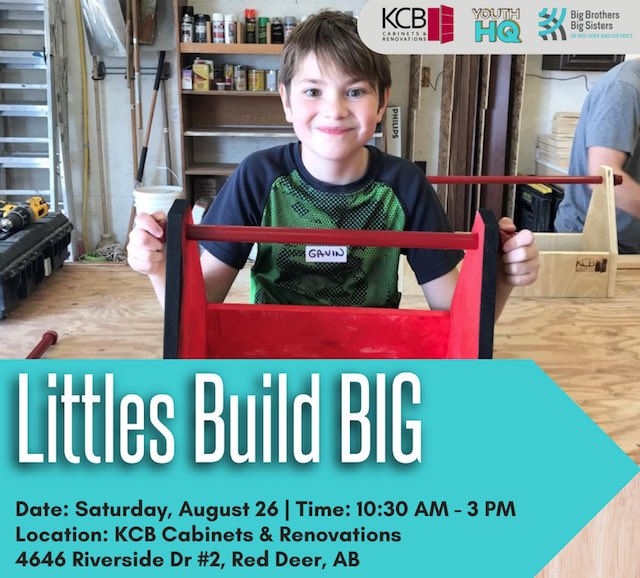Community
Big Brothers Big Sisters hosting free BBQ and family fun for the community at KCB Cabinets

LITTLES BUILD BIG LOOKS TO BE EVEN BIGGER FOR YOUTH HQ
On Saturday, August 26, Big Brothers Big Sisters of Red Deer & District invites everyone to come down to KCB Cabinets & Renovations for the returning Littles Build BIG event. While Littles and waitlist youth from the Big Brothers Big Sisters program build toolboxes, staff and volunteers will be hosting a free barbecue and providing information about the BBBS program to help find potential mentors and provide matches for the many youths waiting on the waitlist. In addition, there will be a bouncy castle and a paid dunk tank with many local celebrities including council member Lawrence Lee, former UFC fighter Jason MacDonald, and Ben Pelletier, a teacher who recently cycled from Vancouver to Halifax while raising funds for the BBBS program.
The event will also serve as the kickoff for September as Big Brothers Big Sisters month in Red Deer, with Red Deer Mayor Ken Johnston in attendance to make the official proclamation.
“It has been an honor to work with Big Brothers and Big Sisters of Central Alberta. Our youth need guidance in this crazy world,” said Carl Sauve, Owner of KCB Cabinets & Renovations and Big Brothers Big Sisters mentor. “Being a mentor, you understand firsthand the benefits you can bring to kids in need and the community you call home. It is easier than anyone would think, so give it a try!”
“We are so grateful to have people like Carl Sauve and businesses like KCB Cabinets and Renovations who understand the positive impacts mentoring has for youth and want to help spread that message,” says Terri Blanchard, Big Brothers Big Sisters of Red Deer & District Manager. “With over 75 Littles waiting for a BIG in the Red Deer area, this event gives us the opportunity to connect with the community in a really fun way and find the amazing mentors we know are out there.”
Anyone is welcome to attend the event. Anyone looking to be in the dunk tank may contact BBBS manager, Terri Blanchard, at [email protected] for more information.

About BBBS of Red Deer & District
Big Brothers Big Sisters has been active for over 100 years. The organization came to the Red Deer & District region in 1976 and has been at work in this community ever since. Several programs and services are available to young persons and their families, including in-school mentoring. BBBS also provides activities for waitlist children and youth (those who haven’t been matched yet) as they wait to be matched with a caring mentor.
About Youth HQ
Youth HQ empowers youth by fostering a community of support. Our network seeks to instill young people with confidence in their unique identities and abilities, providing them with skills for life through knowledge, healthy relationships, and quality experiences while providing safe environments to learn and grow. Youth HQ coordinates programming for Big Brothers Big Sisters of Red Deer & District and BGC of Red Deer & District, offering numerous programs and services that support children, youth, and families.
Community
Support local healthcare while winning amazing prizes!

|
|
|
|
|
|
|
Community
SPARC Caring Adult Nominations now open!

Check out this powerful video, “Be a Mr. Jensen,” shared by Andy Jacks. It highlights the impact of seeing youth as solutions, not problems. Mr. Jensen’s patience and focus on strengths gave this child hope and success.
👉 Be a Mr. Jensen: https://buff.ly/8Z9dOxf
Do you know a Mr. Jensen? Nominate a caring adult in your child’s life who embodies the spirit of Mr. Jensen. Whether it’s a coach, teacher, mentor, or someone special, share how they contribute to youth development. 👉 Nominate Here: https://buff.ly/tJsuJej
Nominate someone who makes a positive impact in the live s of children and youth. Every child has a gift – let’s celebrate the caring adults who help them shine! SPARC Red Deer will recognize the first 50 nominees. 💖🎉 #CaringAdults #BeAMrJensen #SeePotentialNotProblems #SPARCRedDeer
s of children and youth. Every child has a gift – let’s celebrate the caring adults who help them shine! SPARC Red Deer will recognize the first 50 nominees. 💖🎉 #CaringAdults #BeAMrJensen #SeePotentialNotProblems #SPARCRedDeer
-

 COVID-199 hours ago
COVID-199 hours agoOntario man launches new challenge against province’s latest attempt to ban free expression on roadside billboards
-

 Energy17 hours ago
Energy17 hours agoThis Canada Day, Celebrate Energy Renewal
-

 Business1 day ago
Business1 day agoWhile China Hacks Canada, B.C. Sends Them a Billion-Dollar Ship Building Contract
-

 Alberta1 day ago
Alberta1 day agoSo Alberta, what’s next?
-

 Alberta7 hours ago
Alberta7 hours agoAlberta Next Takes A Look At Alberta Provincial Police Force
-

 Bjorn Lomborg1 day ago
Bjorn Lomborg1 day agoThe Physics Behind The Spanish Blackout
-

 Alberta9 hours ago
Alberta9 hours agoCanadian Oil Sands Production Expected to Reach All-time Highs this Year Despite Lower Oil Prices
-

 Business12 hours ago
Business12 hours agoPotential For Abuse Embedded In Bill C-5








